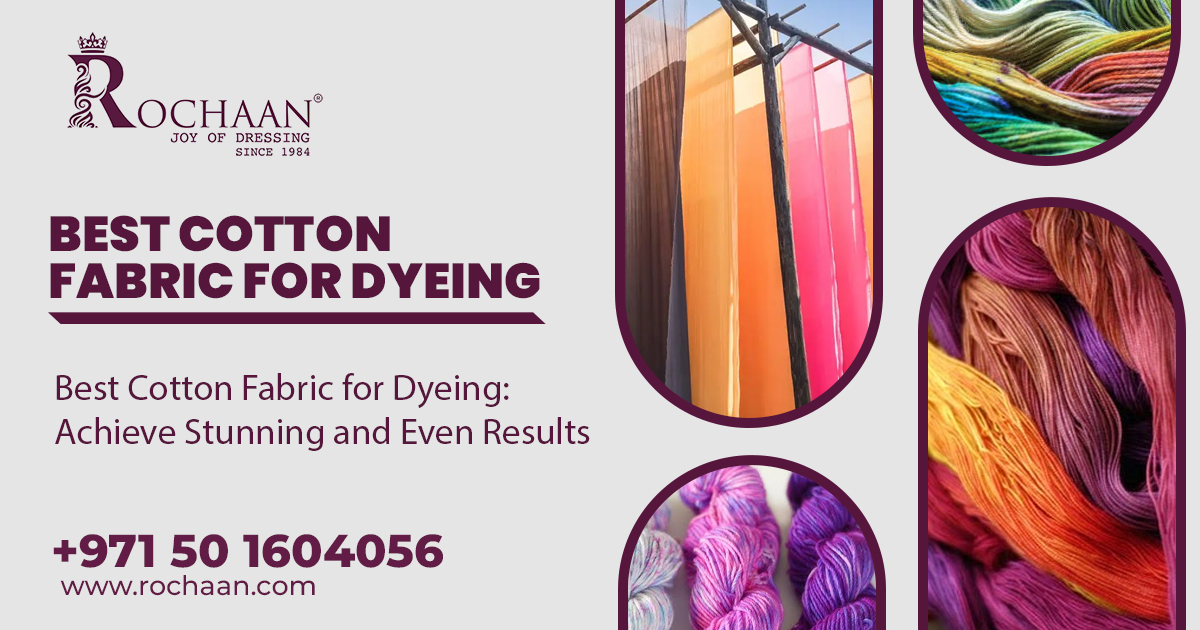Cotton fabric for dyeing is one of the favorites of crafters and textile artists when it comes to dyeing fabrics: its natural fibers soak up so much ink, whether in the form of a free-flowing dye bath or intricate detail work, to produce the most colorful results. Unfortunately, not all cotton fabrics are created equal in dyeing.

The Top 5 Cotton Fabrics Are The Best Candidates For Dyeing And Promise To Deliver The Most Eye-Pleasing Results.
1. Cotton Muslin
This is an unbleached lightweight cloth known as cotton muslin. It is extensively used for a wide range of sewing and crafting projects. Its smooth finish makes it a good choice for dyeing since it does soak up dyes uniformly. The cloth comes in different weights; however, the lighter versions are much preferred for dyeing since they allow fluid application and quick drying times.
It is as economical as it is affordable, making it the best fabric for beginners who are trying out muslin specifically to experiment with dyeing the fabric.
Cotton muslin is a good fabric choice for any simple tie-dye project or even for advanced techniques in dyeing. The cotton muslin can assure you and deliver nice results.
2. Cotton Sateen
Another good fabric to dye is cotton sateen, which has a very high finish and sheen. This weave has been done to give the fabric a soft, silky surface, and there’s no better fabric than this one for creating garments with a bit of elan. Cotton sateen is often rather richly colored when dyed.
Cotton sateen has a very smooth surface, and fine patterns and designs can be seen within the dyeing process. Its weight suits various projects, from dresses to home decoration. However, the gloss may alter how much the fabric takes the dye, so a test sample would be recommended to ensure proper color saturation.
3. Cotton Canvas
Cotton canvas can be solid and adaptable, making it popular among artists and designers. Heavily weighted, it provides a robust ground for different dyeing techniques, such as batik and shibori, which are well-suited to this kind of canvas. Since tightly woven cotton canvas absorbs the dyes relatively evenly, the created patterns often turn out sharp and well-defined.
4. Cotton Lawn
Cotton lawn is a very light, finely woven fabric. It is often used to create a variety of garments, particularly blouses or dresses. Its silky softness makes it very pleasant to work with. It dyes beautifully, providing a delicate finish. The dye spreads uniformly on the smooth surface of the cotton lawn and works well for colors and beautiful patterns.
The cotton lawn is a delicate fabric for dyeing that is best suited for lighter applications, such as dip-dye or watercolor effects. Its wonderful weave also makes it excellent when details are required to pop, and it is ideal for anyone needing visually striking garments.
5. Cotton Poplin
Cotton poplin is one of the most favorite fabrics by fashion makers. It provides a crisp finish and smooth texture. This light cotton is also very fine to dye, as it absorbs color, and the result is lovely and rich in color combination. Much preferred for shirts and dresses, cotton poplin also proves to be an ideal fabric for quilting.
The tight weave of the fabric enables many dyeing techniques, ranging from direct application to immersion dyeing.
Tips for Dyeing Cotton Fabrics
Once you have selected your cotton fabric for dyeing, here is a bit of best practice that you must follow for the best results:
Pre-wash the Fabric: Always pre-wash your cotton fabric because it might have sizing or finishes that could interfere with dye soaking up. That way, you can ensure that the dye enters the fibers well.
Test Before You Dye: Always test dye on a small piece of fabric before dyeing your project. It will help you predict how your fabric will work with the dye and enable you to shift your technique based on what happens.
Follow Instructions: Before starting to work, read the instructions of the dye manufacturer very carefully for preparation, application, and setting because each type of dye has its requirements for giving the best results.
Fix the Dye: After a dyeing process, the dye has to be fixed so that longevity is not guaranteed; otherwise, it is not assured. This usually involves rinsing the cloth and applying the fixative or setting solution as suggested in the instructions on the manufacturer’s label.
Conclusion
Various types of cotton fabrics may be dyed to superb effects. Whichever kind of muslin, sateen, canvas, lawn, or poplin you select, they all have inherent characters that will help you do magnificent work. Knowing which type of cotton fabric for dyeing
is best used for dyeing and adhering to the procedures outlined here, beautiful and vibrant designs will surely come out, giving you your desired creative visions. Happy dyeing!
Visit our store Buy high-quality fabrics at Rochaan.
FAQs
What would be an ideal cloth to dye in cotton?
The best cotton dyes are muslin, sateen, canvas, lawn, and poplin. Each has characteristic properties that absorb dye differently and appear differently after dyeing. Cotton muslin is excellent for beginners because it is affordable and easy to dye, whereas cotton sateen gives a luxurious look.
How should I prepare cotton cloth for dyeing?
It is widely understood that any cotton cloth should be pre-washed before dyeing. This removes all the sizing or finishes, preventing the dye from entering the fibers. After being washed, the fabric must dry before applying the dye.
What dye goes best for cotton fabrics?
For starters, cotton fabrics are painted using fiber-reactive dyes, in which chemical bonds are created to the fibers to make the colors permanently deep. One may also use all-purpose dyes, but the result may not be permanent and vibrant. Always follow manufacturer instructions when using dyes for the best results.
